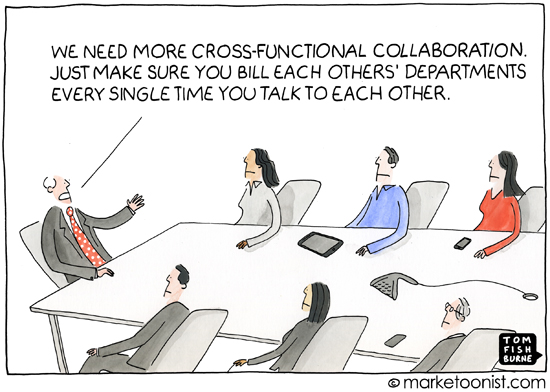This cartoon came out of a conversation with a marketer recently about the silos in her company. Her company was trying to encourage more collaboration across teams and divisions. They wrote values statements and held off-sites on the importance of cross-functional collaboration.
At the same time, in the name of efficiency and cost controls, her company carefully calculated who spent time on which projects to a minute level of detail. That time was then billed back to the department leading the project.
I get the efficiency argument and the difficulty of managing limited resources. But this company’s cost center emphasis ultimately created a reluctance for different groups to talk to each other at all. People were required to financially justify resources before even scheduling a meeting. So, the path of least resistance became not to invite anyone. And the silos only became more established.
Overcoming silos is universal business challenge. Years ago I worked in a business where the marketing team was based in Oakland, California and the R&D center was based in Bakersfield. There was no easy way to travel between the two offices. The best option was a 4-hour one-way drive. So, in most cases, we relied on conference calls to communicate. But no matter how we tried, that 4-hour drive created a chasm of misunderstandings that negatively impacted projects.
I often drove 4 hours one-way for a two-hour meeting in an attempt to narrow that chasm. My managers would frequently challenge me on the value of investing so much time in the car just to meet face to face. But I found that our projects invariably went smoother when I did.
As companies optimize resource costs, it’s important to factor in the cost of not collaborating. I’d love to hear your thoughts on overcoming silo thinking.



Sylvie St-Amand says
Silos in a company are a plague for any marketing department, which should be the central information hub about anything that goes on in a company. This lack of information, in my opinion, leads to many lost opportunities and useful fine-tuning in marketing strategy. This is why it is so important to open channels of communications, ensuring that everyone is heading in the same direction.
Nick Allen says
I love the (if somewhat radical) work Tony Hse is doing at Zappos with holacracy.
It’s hard to form silos in a flat structure.
I realise for most, the system is set, but for those willing to change Co – locating marketing / sales and innovation is start to encouraging the break down of silos.
Nick
Garry Upton says
Humor, a great way to uncover great corporate sins. Within some companies, downsizing effective cross-silo-reaching employees and hiring them back as “consultants,” has overcome the madness…
chris Jangelov says
And while management try to organize rather than use the people available all over the organization, the ones with alternatives will leave the grown-up playground and work in a more mature place.
Another thing to remember is that if you organize collaboration between silos, only the usual suspects/ideas will meet.
Peter Mulraney says
Isn’t it interesting that in the name of efficiency we forget that we work for the one organisation – whether it’s a company or a government agency.